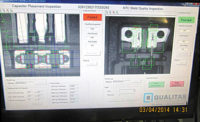Many electronic device manufacturers require their suppliers to inspect 100 percent of all supplied parts, to ensure that shipments contain only defect-free parts. Steve Koopman, manufacturing engineer, says, "Inspection accuracy is a critical aspect of our business. Faulty components result in device failure and damage the device manufacturer's reputation. Our customers rely on us to provide reliable connectors." Some of the essential inspections for electronic connectors include pin presence and absence, coplanarity and true position. These features are critical to successful seating of the connector on the PCB and mating of the connector to a cable.
Previously, part inspections were performed manually. However, manual inspections had to end when the company began producing tiny, high-density connectors. Some of these high-density connectors can have up to 500 pins in multiple row configurations. With such a large quantity of small pins, the human eye is incapable of discerning coplanarity. Therefore, despite a high degree of expertise within the inspection group, visual inspection of the new high-density connectors achieved an unacceptable accuracy level.
According to Koopman, "We needed a machine vision inspection system capable of discerning individual coplanarity among 500 tightly grouped pins with 100 percent accuracy." Additional goals for machine vision inspection included reducing inspection labor hours and increasing the rate of throughput.
Koopman selected Passport DSL (Digital Serial Link) systems from PPT Vision Inc. (Eden Prairie, MN). Passport DSL systems use a two-way digital serial communications network. Up to 16 digital cameras can be connected to the processor using simple twisted-pair cables. The systems' Vision Program Manager (VPM) software includes the custom connector tool which features multi-image stitching. This allows users to zoom in on a small section of a connector and take several high-resolution images of the part as it passes under the camera. The software then stitches these images together into a complete view of the whole connector for increased inspection precision. The VPM software also streamlines setup by replacing lines of code with graphic programming tools that users drag and drop into flowcharts.
The Passport DSL system now provides rapid and reliable 100 percent part inspection of several of Samtec's products. The system also helps to resolve production problems quickly by alerting the operator to the first defective part. Samtec has integrated the Passport DSL systems with secondary assembly equipment, allowing them to perform 100 percent part inspection as a "throughput-free" operation. Part inspection is performed simultaneously with secondary assembly operations, such as pick-and-place pad applications.
In addition to the original goals of increasing quality percentages and throughput speed, the Passport DSL has decreased scrap, rework, maintenance time and replacement of part costs. According to Koopman, "Passport DSL may extend the useful life expectancy of our equipment by enabling us to detect production problems early, so we can adjust and calibrate, rather than shutdown and repair."
For more information on machine vision inspection systems, call PPT Vision Inc. at 952-996-9500, visit www.pptvision.com or Reply 1.



